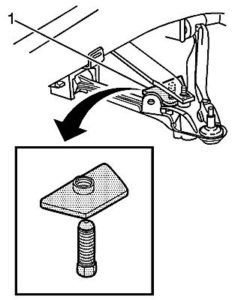 The 2005-‘13 Corvette is the sixth-generation Corvette, often called the C6. There is nothing exotic about performing an alignment on a C6. In fact, you may find the C6 is easier to align than many other cars and SUVs. In some cases, the biggest problem with aligning a Corvette has nothing to do with the vehicle and everything to do with the owner — some of whom listen more to keyboard warriors than common sense.
The 2005-‘13 Corvette is the sixth-generation Corvette, often called the C6. There is nothing exotic about performing an alignment on a C6. In fact, you may find the C6 is easier to align than many other cars and SUVs. In some cases, the biggest problem with aligning a Corvette has nothing to do with the vehicle and everything to do with the owner — some of whom listen more to keyboard warriors than common sense.
Initial Inspection
When going for a test drive or pulling a C6 into the shop, look at the dashboard and driver information center for any messages or MIL lights for the ABS/ESC and ride control systems. Listen for any clunks or noises when going over bumps. The leading cause of noise is typically the sway bar links.
Take time to inspect the tires. Due to the different sizes and directional tread patterns, you will not be able to rotate a bad tire to cancel out a pulling condition caused by the tires. In some cases, worn bushings can cause inner edge tire wear problems.
Note: The C6 has a low nose with a lot of overhang. Getting it on the rack without scraping the nose on some ramps may take extra care if your bay is not set up to handle these types of vehicles.
Front Suspension
The C6 Corvette comes with camber and caster adjustments built into the control arms. The lower control arm is equipped with two cam bolts that can change camber and caster, which are tied together. If caster is adjusted, camber will change; if camber is adjusted, caster will change. Always check both angles after an adjustment. The front lower control arm cam bolt nuts have a torque specification of 125 ft.-lbs.
According to some Corvette specialists, the caster should be as close as possible to the stock specification. Too much positive caster can increase steering effort due to the 275 mm front tires. In a worse-case scenario, it can also cause the power steering system to run hot and potentially fail.
 Rear Suspension
Rear Suspension
The rear suspension is very similar to the front with the same arrangement of cam bolts on the lower control arms to adjust camber. GM recommends using both cams to make an adjustment. Tighten the rear lower control arm front cam bolt nut to 107 ft.-lbs and the rear cam bolt nut to 70 ft.-lbs.
Electronic Suspension Option
For most years of the C6, an ESC system was an option. Known as Magneto-Rheological Real Time Damping (MRRTD), the system independently controls the fluid viscosity in each of the four shock absorbers in order to control the vehicle’s ride characteristics. The ESC system is capable of making these changes within milliseconds.
The most common failure is the suspension position sensor linkages that connect to the control arms. Over time, the ball and socket can wear out or the link can be damaged by road debris.
The system will display the messages “Service Ride Control, Shocks Inoperative” or “Speed Limited/Shocks Inoperative” if a problem is detected. The system uses an ignition cycling diagnostic approach in order to reduce the occurrence of false or intermittent DTCs that do not affect the functionality of the ESC system. This allows for the “fail-soft” actions to be taken whenever a malfunction condition is current, but requires the malfunction to be current for a certain number of ignition cycles before the corresponding malfunction code and message will be stored or displayed.
Steering
The steering position sensor on the C6 is initialized or calibrated every time the ignition is turned on and the vehicle is driven. The system uses the lateral accelerometer, yaw rate sensor and other ABS inputs to determine the position of the wheel and direction of travel. Slight changes in the toe and thrust angle shouldn’t impact performance of the steering sensor and shouldn’t require recalibration with a scan tool.
The 2005-‘08 C6 models had a recall for the wiring going to the sensor. The issue involved a defective connector and the telescoping mechanism of the steering column that would cause the resistance value and sensor voltages to change.
Run Flats
Like the C5, the C6 Corvette comes standard with run-flat tires and a TPMS system. Some owners have replaced the stock run-flat tires with regular tires to reduce replacement costs and improve ride quality. The natural wear pattern of the tires is on the inside edge. Some owners may request a less aggressive camber setting they found on a Corvette forum to improve tire wear. Most of the specs are well within the factory tolerances.
Resetting the TPMS sensors requires a key fob and TPMS activation tool. Turn the ignition switch to the accessory position and press lock and unlock simultaneously on the key fob. The horn should chirp. Starting at the left-front, hold the TPMS activation tool to the sidewall below the valve stem — the horn should chirp after the activation button is pushed. Relearn the sensors in the following order: right-front, right-rear, left-rear and left-front. Once completed, the horn will chirp twice. Turn the ignition switch off to exit the learn mode.
Save














